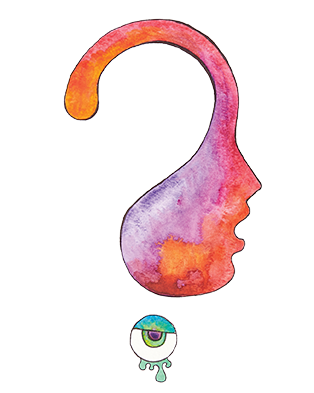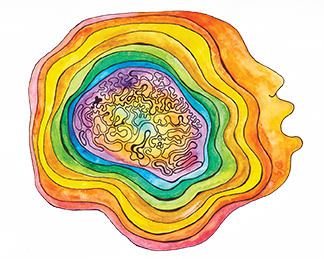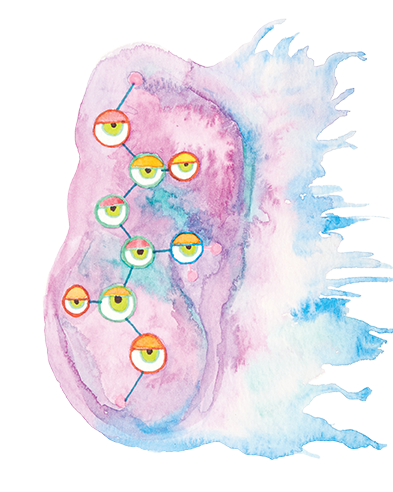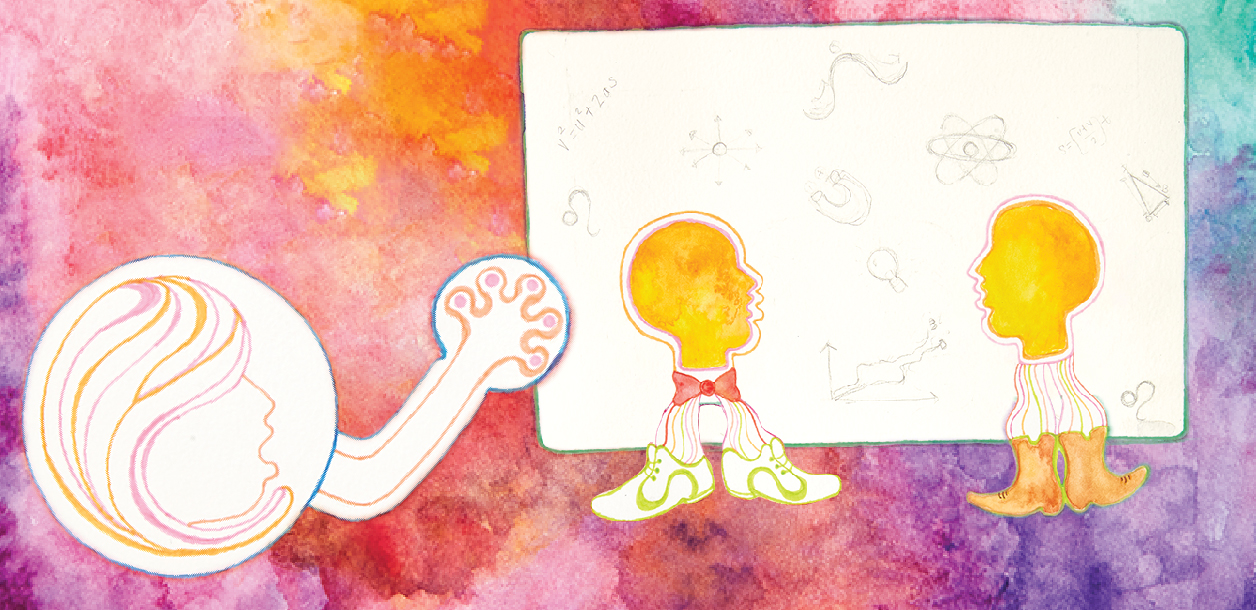What if the answer wasn’t the goal? What if the joy was found in asking a better question? Individualized Study instructors Stephen Freeland and Eric Brown eagerly invite their students to delve into the mystery and wonder of the world, balancing that awe with an intrepid curiosity that doesn’t accept surface-level explanations. What can we learn about ourselves, they ask, when we don’t expect a ready-made answer to our questions?
Stephen Freeland and Eric Brown ’93, M1, interdisciplinary studies, stand off to either side of the Fine Arts classroom. Playfully adversarial, the two Leos know how to pull each other’s levers. The question on the whiteboard asks the students in Brown’s Human Context of Science and Technology class to reconsider life as they know it: the origins of life, the evolution of life, the label “intelligent life”—and not just here on our blue marble, but in galaxies far, far away.
Freeland and Brown are not scared away by “what if” questions. Freeland, an evolutionary biologist, and Brown, with a background in the history of science, both find their homes in UMBC’s Department of Individualized Study (INDS). The pair seems like they would thrive under the interrogation of any 4-year-old’s barrage of “whys.” But this childlike curiosity isn’t aimless (it never is). Instead, the colleagues of almost a decade take great pleasure in finding ways to question established scientific norms and help students eschew culturally constructed labels that might accidentally shield them from further scientific discovery.
Some of the students eagerly step into the scrum. Being asked to question something as fundamental to her biology studies as the moment of the origin of life clearly takes Emma Galambos ’23, psychology, aback.

As she wraps her head around what Freeland is positing, Galambos peppers him with questions about a basic tenet in most biology textbooks. Developed as an idea in the 1960s, the “RNA World” hypothesis states that life began with a simple RNA molecule that could copy itself without help from other molecules, like DNA and proteins. And somewhere in this RNA-only universe, the origin of life happened. It’s a commonly featured point on famous graphs that claim to explain the pre-biotic origins of the universe.

Freeland thinks, to put it simply, this is rubbish. But despite Freeland’s extensive background in evolutionary biology, Galambos has a few things to push back on—which is something Brown actively fosters with his students.
“I was taught the RNA World hypothesis in previous courses, that RNA was the precursor for life,” says Galambos, reflecting on the exchange after the class concluded. Currently an EMT who plans to attend nursing school after graduation, Galambos says, “I’ve been taught that there was a distinct origin of life and Dr. Freeland’s concept goes against this idea, but I find his explanations and ideas very fascinating.” Brown facilitates the in-class conversation by occasionally prodding Freeland to expound on his alternative take.
Freeland goes on to outline his proposal on the board with a few simple x-y axes, changing what looks like a sharp vertical upswing into a more nuanced diagonal line (to indicate there may have been one or more stages before RNA, from which RNA later evolved). “Something that grows out of the natural way I do science, and what has made me a scientist,” says Freeland, INDS director, “is to imagine the counterfactual. You imagine what it isn’t, in order to see more clearly what it is.”
He’s currently trying to publish a paper that questions the dominant paradigm of the RNA World hypothesis while also working on a review for a different manuscript that criticizes the well-accepted theory. He emphasizes the word trying, “as it’s sort of proven to be strangely unpublishable,” he says with a wry smile, “at least within the U.S.”
Regardless of any professional hurdles, the joy that Freeland and Brown bring to this scientific tug-of-war is evident in their ease with each other and the way they eagerly invite the students into the mystery and wonder of the world with reverence—and a healthy dose of skepticism.
The alien problem
Similarly unpublishable to an extent is genuine scientific inquiry into the existence of extraterrestrial life. Not that it’s stopping Avi Loeb, chair of Harvard’s astronomy department. Loeb is the jumping off point for Freeland and Brown’s classroom conversation: how does a well-respected astrophysicist earn the ire and interest of colleagues across the globe? Belief in aliens is the short answer, and the slightly longer version is by sincerely positing the likelihood of communicative life near and far using an equation developed in 1961 by Frank Drake.
Brown jots a formula on the board. Known as the Drake equation, it attempts to solve for the numbers of technologically advanced civilizations in the galaxy, using factors like the average number of planets in the Milky Way that can potentially support life per star that has planets, the fraction of planets with life that actually go on to develop intelligent life, the length of time for which such civilizations release detectable signals into space, etc.
It’s more of a thought experiment than a mathematical formula, but it’s had broad implications for how astrophysicists consider extraterrestrial life. Brown wraps up the exchange with what could be a loaded question to his colleague: “So, your estimation then is that there’s a lot of life in the galaxy?”
“Yes,” Freeland gamely replies. “But I’m growing more careful to say that there has been a lot of life in the galaxy.”
“It could be a cosmic graveyard out there,” Brown follows up. “Yes, life comes about and then life disappears. It could be that one of these terms in the Drake equation is a really, really small number.”
There are other even more banal and prosaic reasons we haven’t discovered signs of life elsewhere, says Freeland. We haven’t tried.
“Our state of actual scientific knowledge about our own cosmic backyard and neighboring planets is minimal, zero,” says Freeland. “Our species has only conducted three full experiments to test for the existence of life outside of Earth, and they were all on Mars and they were all in 1977. One of those three is still up for debate because by the standards that they began the experiment, it demonstrated there was life. The consensus was to re-explain the outcome.”
“All of that is to say,” says Freeland, “don’t mistake this: there is an absence of evidence, not an evidence of absence. That would be my biggest point to you.”
Upsetting the established balance

Freeland and Brown are using the example of extraterrestrial life as a starting point in their discussion, but they’re not just interested in the possibility of little green people arriving in spaceships—although they wouldn’t turn them away. Freeland and Brown see the opportunity to open students’ minds to question self-reinforcing patterns: something is “discovered,” then put in a textbook, then taught for decades, and now it is true. This could be said about well-regarded theories of the origin point of life to other entrenched systems like white patriarchy, Freeland gives as an example.
“It comes to this vicious circle where we’ve created a culture that can’t remember to see it other than the way our culture sees it,” says Freeland. “And as time goes on, it actually gets progressively harder and harder for alternatives to penetrate that.”
“Part of the reason why I don’t believe in capital T truth,” Brown addresses his students, “is because I think humans are good at tricking ourselves into believing that we have discovered the truth about the world. And then, in 100 years when that’s no longer the truth, we’re also very good at telling retroactive stories about how those people were just mistaken.”
So what is true?

Brown’s and Freeland’s shared astrological sign popped up earlier in the class when they asked the students if they put any stock in the zodiac. The students were wary of aligning themselves with the stars, but Freeland and Brown are quite happy to explore what the social ramifications are of always hearing about being a Leo actually contributing to their natural sense of self-assurance. In this way, something becomes (lowercase-t) “true,” a truth defined by shared experience as opposed to objectivity.
Many things students dutifully copy from lectures and textbooks and assume are truthful building blocks are actually obsolete concepts at this point, Brown and Freeland point out. Like scientific discoveries of old, it’s difficult for society to adjust to new information. Galileo was sentenced to life imprisonment for his heliocentric views—in our age maybe that looks like a denied tenure package or rejected manuscripts for questioning the scientific norm.
“What’s interesting about this to me,” says Brown, “is that it seems so anti-scientific, that I can’t believe something or I can’t argue something because this other proposed theory has won the current approval, even if I have evidence otherwise. Ought it not be that it’s the evidence that guides you?”
“The danger here,” replies Freeland, “is if we mistake the model that we are using and the labels that we’ve all grown familiar with—if we mistake them for objective reality…then we’re never going to see past those labels.” Freeland points to UMBC’s Kevin Omland, professor of biological sciences and expert on the evolutionary biology of birds, to make his point. “Omland is finding that actually the more we study, the less there is an objective line to say where one species begins and another one ends. That’s not to say that labels can’t be useful, but they mean different things, depending on what question you’re asking.”
Freeland brings that back around to his own research—debunking the moment of the origin of life. Pointing again to his alternative theory, the diagonal line representing gradual interplay of RNA and DNA, Freeland says, “what is interesting to me about that diagonal line is that there’s nowhere on that to call the moment of the origin of life. The origin of life is actually a seamless part of the unraveling of the universe, the way that time and energy can make the universe go. That’s a much more interesting universe, really.”
Asking better questions

What purpose is there in asking big questions we’ll (probably) never know the answers to? Aristotle famously addresses this human tendency in the first sentence of Metaphysics: “All men by nature desire understanding.” For some, that understanding leads down an unfamiliar but fulfilling path that might make your colleagues—or your students—uncomfortable with the destination.
Galambos says that Brown doesn’t hesitate to share “that a student changed his perception or will continue to ask the student further questions about how they got to the idea” because he seems naturally intrigued by his students’ responses. Freeland and Brown are not alone in their mission to revive and share their students’ natural curiosity about the world—or at the very least help them learn how to ask better questions. It’s one of the pillars of UMBC’s mission to welcome all students to our community of inquiring minds.
“And the further I go,” says Freeland of his 25-plus year research career, “the more I’m convinced, like all good research, what you learn is where the question was wrong, and the question gets better rather than getting an answer.”
*****
Illustrations by Michelle Rudman.
Tags: CAHSS, Fall 2021, illustration, INDS, Psychology

